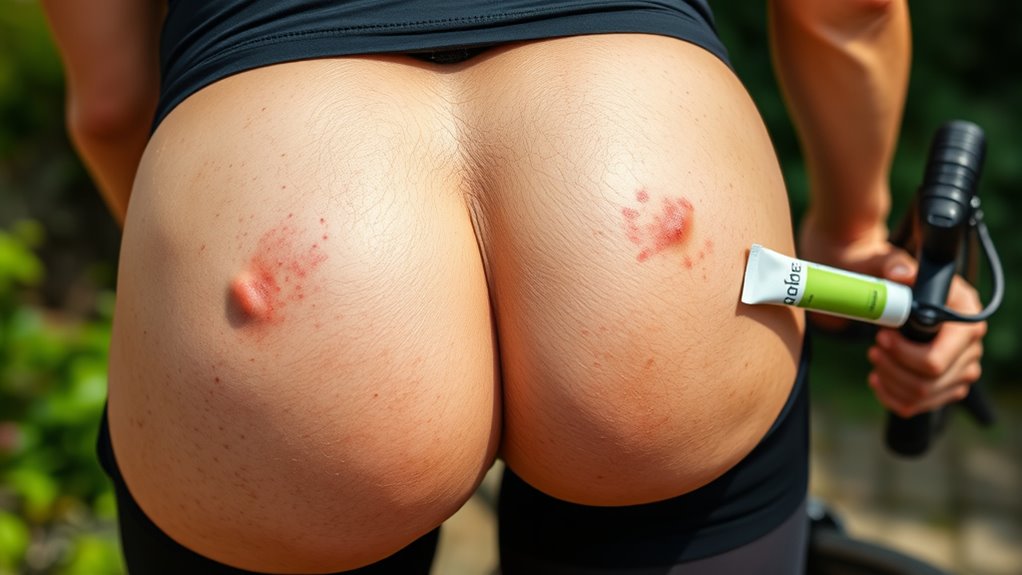To prevent saddle sores, you should adjust your saddle height and tilt to fit comfortably and avoid friction, and use moisture-wicking shorts with good padding. Keep your area dry, apply anti-chafing creams or petroleum jelly before riding, and take breaks to shift positions. After a ride, gently clean the area and apply soothing ointments. If soreness persists, it’s time to reassess your saddle fit or gear—keep going to learn more about proper care and prevention.
Key Takeaways
- Apply anti-chafing creams or powders before riding and keep the area dry during long rides.
- Ensure proper saddle height, tilt, and position to distribute pressure evenly and prevent irritation.
- Address discomfort immediately by adjusting saddle settings or shifting positions to reduce hot spots.
- Clean affected areas gently post-ride and use soothing ointments to promote healing.
- Maintain good hygiene, use quality padded shorts, and regularly check and adjust saddle fit for ongoing comfort.

If you spend a lot of time cycling, you’ve probably experienced saddle sores at some point. These painful irritations can turn a great ride into a miserable experience, but the good news is that many saddle sores are preventable and manageable. One of the first steps is understanding how to use chafing remedies effectively. Applying anti-chafing creams or powders before your ride can create a protective barrier that reduces friction and keeps your skin from breaking down. Some cyclists swear by petroleum jelly or specialized chamois creams, which help minimize chafing and soothe sore spots if they do develop. Additionally, wearing moisture-wicking shorts with a good chamois pad helps keep the area dry and reduces friction during long rides.
Prevent saddle sores with chafing creams, moisture-wicking shorts, and proper saddle adjustments for comfortable cycling.
Beyond topical remedies, saddle adjustment techniques play a vital role in preventing saddle sores. An improperly fitted saddle can cause unnecessary pressure and friction in sensitive areas, leading to irritation. To avoid this, start with a proper saddle height, ensuring your leg has a slight bend at the knee when the pedal is at the bottom of the stroke. Adjust the saddle tilt so it’s level or just slightly nose-down; this prevents pressure from shifting forward or backward. Forward or backward saddle positioning influences how your weight is distributed, so fine-tune it until you feel balanced and comfortable. Remember, small adjustments can make a considerable difference, so take your time to find the best setup.
When you’re riding, pay attention to how your body feels. If you notice discomfort or hot spots developing, don’t ignore them. Adjust your saddle height or tilt on the spot if possible, or consider switching to a different saddle shape or padding. Sometimes, saddle sores result from prolonged pressure on a specific area, so taking breaks during long rides and shifting your position can also help prevent issues. Wearing clean, well-maintained shorts and changing out of sweaty gear promptly after riding will keep your skin healthier and less prone to irritation.
If a saddle sore does develop, clean the area gently with mild soap and water, then apply a soothing ointment or chafing remedy to promote healing. Avoid tight clothing that could rub or trap sweat, and give yourself time to recover before heading out again. Most importantly, listen to your body—pain or persistent soreness isn’t normal and warrants addressing saddle fit or gear before it worsens. With proper saddle adjustment techniques and attentive care, you can considerably reduce saddle sores and enjoy your cycling sessions more comfortably.
Frequently Asked Questions
Can Saddle Sores Lead to Serious Infections?
Yes, saddle sores can lead to serious infections if left untreated. Bacterial infections may develop, causing redness, swelling, and pus. In some cases, saddle sores can progress to skin abscesses, which are painful and may require medical intervention. To avoid this, keep the area clean and dry, and address any sore promptly. Proper care prevents bacteria from entering and causing more severe infections.
How Long Do Saddle Sores Typically Take to Heal?
Most saddle sores heal within 3 to 7 days, but the healing timeline varies depending on factors like sore severity, skin type, and hygiene. You can speed recovery by keeping the area clean, avoiding friction, and resting. If sores worsen or don’t improve after a week, consult a healthcare professional. Staying attentive to these factors influences recovery, so proper care helps you get back to riding faster.
Are There Specific Clothing Materials That Prevent Saddle Sores?
Yes, wearing clothing made from moisture-wicking fabrics helps prevent saddle sores by keeping your skin dry and reducing friction. Padded shorts are also essential, as they provide extra cushioning and minimize pressure on sensitive areas. Opt for well-fitting, breathable materials to enhance comfort during rides. Combining moisture-wicking fabrics with padded shorts creates an effective barrier against irritation, helping you stay comfortable and avoid saddle sores altogether.
Should I See a Doctor for Mild Saddle Soreness?
You should see a doctor for mild saddle soreness if it persists or worsens despite using home remedies like ice packs, over-the-counter creams, and proper cycling gear. While most soreness improves on its own, a doctor can check for infections or other issues. Don’t ignore ongoing discomfort; seeking professional advice guarantees proper treatment and quicker recovery, helping you get back on your bike comfortably.
Can Diet Affect the Development of Saddle Sores?
Your diet can substantially impact the development of saddle sores by influencing your skin health, immune response, and inflammation levels. Nutrition impact is evident when you maintain proper dietary habits, such as staying hydrated, consuming anti-inflammatory foods, and avoiding excessive sugar or processed foods. These habits help keep your skin resilient, reduce irritation, and promote faster healing, ultimately lowering your risk of saddle sores. Prioritize balanced nutrition for healthier, more protected skin.
Conclusion
Remember, with gentle attention and the right precautions, you can keep your riding experience smooth and comfortable. A little care goes a long way in maintaining your delicate balance and ensuring your journey remains enjoyable. Embrace the wisdom of listening to your body’s whispers, and don’t shy away from moments of rest. By tending to these subtle signals, you’ll preserve your harmony on every ride, turning potential discomfort into a quiet declaration to your dedication.









